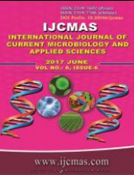


 National Academy of Agricultural Sciences (NAAS)
National Academy of Agricultural Sciences (NAAS)

|
PRINT ISSN : 2319-7692
Online ISSN : 2319-7706 Issues : 12 per year Publisher : Excellent Publishers Email : editorijcmas@gmail.com / submit@ijcmas.com Editor-in-chief: Dr.M.Prakash Index Copernicus ICV 2018: 95.39 NAAS RATING 2020: 5.38 |
An experiment was conducted to assess genetic divergence among 60 inbred lines included 27 maintainer (B-) and 33 restorer (R-) lines of pearl millet based on quantitative data of grain yield and its ten component traits using hierarchical cluster and principal component analysis (PCA). The PCA identified four principal components (PCs) with Eigen value greater than 1.00 and accounted for 70.97 per cent of total variation. Most important traits in PC1 are days to 50 per cent flowering, plant height, ear length, ear diameter, grain yield per plant, fresh stover yield per plant, dry matter yield per plant and grain harvest index and captured 26.85 per cent of total variation. PC2 was represented by ear diameter and dry matter yield per plant and contributed 18.06% of total variation. Two characters, grain yield per plant and grain harvest index contributed positively on all the first four PCs. Cluster analysis grouped the inbred lines into eight clusters and the characters, plant height, 1000 grain weight, dry matter yield per plant and productive tillers per plant contributed maximum towards genetic divergence. The grouping patterns of parental lines in PCA and cluster analysis were almost in agreement with each other with minor deviations. The study noticed maximum inter cluster distance between lines of cluster I and II with cluster VII, indicating that lines included in these clusters may have high heterotic response and produce better seggregants when used in Pearl millet hybridization programme.
 |
 |
 |
 |
 |